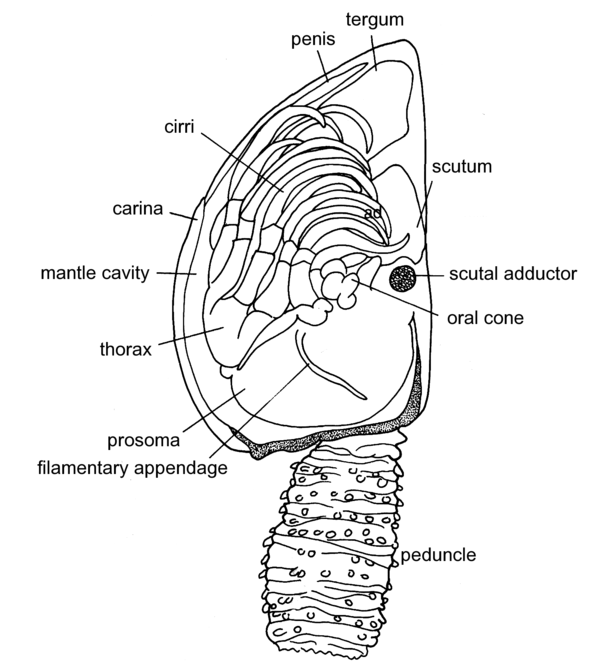- peduncle
- A stalk-like structure [AHD].Basal portion of certain appendages; also fleshy part of body in some cirripeds (Lepadomorpha), between capitulum and attachment to substrate with or without armor of chitinous or calcareous beads, scales, or filaments [Moore and McCormick, 1969].Basil articles of antennules and antennae [Holdich and Jones, 1983].Proximal segments of biramous limb, especially of antennule, antenna, pleopods and uropod. (Syn. protopod, sympod) [Poore, 2004].Stalk in lepadomorph cirripeds, supporting capitulum, attached to substrate by opposite end, commonly armed with calcareous scales [McLaughlin, 1980].Stalklike structure supporting another structure or organ; in shrimps, main reference to part of antennule or antenna; sometimes another term for eyestalk [Butler, T.H.].The three proximal segments of the antennule. The five segments of the antenna of which the second and third are fused (referred to as the second + third segments) [Ingle, 1983].(Order Cladocera):Basal part of each antenna. Relatively long, bearing two- to foursegmented dorsal and ventral branches (rami) [Stachowitsch, 1992].(Order Cumacea):Proximal division of antennule or antenna (peduncle, flagellum). If fully developed, consists of three segments in the former, five in the latter. May also refer to proximal part of pleopod or uropod [Stachowitsch, 1992].(Order Tanaidacea):Proximal division of antennule or antenna (peduncle, flagellum). If fully developed, consists of four segments in the former, two in the latter (the second bearing an antennal scale). Proximal peduncular segment is large [Stachowitsch, 1992].(Order Decapoda):Proximal of two divisions (peduncle, flagellum) of antennule or antenna. In antennule, typically consists of three segments (also termed protopod) and bears stylocerite. In antenna, typically consists of two-segmented protopod and two- or three-segmented endopod and bears scaphocerite. See: ocular peduncle [Stachowitsch, 1992].(Order Amphipoda):Proximal division of antennule or antenna (peduncle, flagellum), although also applied to base of other appendages (e.g., maxilliped, pleopod, uropod). Typically consists in antennule of three segments, in antenna of five; second peduncular segment of latter bears opening of antennal gland [Stachowitsch, 1992].(Order Isopoda):Enlarged proximal, or basalmost region of an isopod antennule, antenna, pleopod, or uropod; contains intrinsic musculature [Wetzer et al. 1997].(Order Isopoda):Proximal division of antennule or antenna (peduncle, flagellum). Typically consists of three segments in antennule, five segments in antenna [Stachowitsch, 1992].(Order Isopoda):Stalk or proximal part of an appendage, as in antennae [Kensley and Schotte, 1989].(
 )Schematic representation of an isopod illustrating morphological terms. [Kensley and Schotte, 1989](Order Mysida):Three-segmented proximal division of antennule or antenna. Bears pair of flagella in former, flagellum and anntennal scale in latter [Stachowitsch, 1992].(Order Stomatopoda):Proximal portion of antennule or antenna (two-segmented in the former, three-segmented in latter); bears flagella. (See also ocular peduncle) [Stachowitsch, 1992].(Order Leptostraca):Proximal of two divisions (peduncle, flagellum) of antennule or antenna. (three-/four-segmented; fourth segment: with/without process, with tuft of bristles) [Stachowitsch, 1992].(Subclass Cirripedia):(
)Schematic representation of an isopod illustrating morphological terms. [Kensley and Schotte, 1989](Order Mysida):Three-segmented proximal division of antennule or antenna. Bears pair of flagella in former, flagellum and anntennal scale in latter [Stachowitsch, 1992].(Order Stomatopoda):Proximal portion of antennule or antenna (two-segmented in the former, three-segmented in latter); bears flagella. (See also ocular peduncle) [Stachowitsch, 1992].(Order Leptostraca):Proximal of two divisions (peduncle, flagellum) of antennule or antenna. (three-/four-segmented; fourth segment: with/without process, with tuft of bristles) [Stachowitsch, 1992].(Subclass Cirripedia):( ) [Anderson, 1980].Lepas anatifera: left valve removed. [Anderson, 1980](Subclass Cirripedia):(
) [Anderson, 1980].Lepas anatifera: left valve removed. [Anderson, 1980](Subclass Cirripedia):( ) [Anderson, 1980].Lepas anatifera: rostral view; and left valve and cirri removed. [Anderson, 1980](Subclass Cirripedia):In stalked barnacle, one of two external division of body (capitulum, peduncle). Attached to substratum by cement glands; contains ovaries. (naked, armed with scales). (Syn. stalk) [Stachowitsch, 1992].(Class Remipedia):Proximal part of antennule. Consists of two segments (articles), the proximal one bearing pad with numerous aesthetascs, the distal one being bifurcate and bearing two (dorsal and ventral) flagella. May also refer to base of antenna [Stachowitsch, 1992].(Superorder Syncarida):Proximal divison of antennule or antenna (peduncle, flagellum). First segment of peduncle in antennule of anaspidacean and bathynellacean bears statocyst. (two-, three-, four-segmented) [Stachowitsch, 1992].(Order Thermosbaenacea):Proximal division of antennule or antenna (peduncle, flagellum). Consists of three segments in the former; not as clearly delimited in the latter, interpreted as consisting of five segments [Stachowitsch, 1992].(Order Euphausiacea):Proximal division of antennule or antenna. Consists in the former of three segments, the first bearing antennular lappet; in the latter, consists of a single, superficially divided segment which bears opening of antennal gland [Stachowitsch, 1992].
) [Anderson, 1980].Lepas anatifera: rostral view; and left valve and cirri removed. [Anderson, 1980](Subclass Cirripedia):In stalked barnacle, one of two external division of body (capitulum, peduncle). Attached to substratum by cement glands; contains ovaries. (naked, armed with scales). (Syn. stalk) [Stachowitsch, 1992].(Class Remipedia):Proximal part of antennule. Consists of two segments (articles), the proximal one bearing pad with numerous aesthetascs, the distal one being bifurcate and bearing two (dorsal and ventral) flagella. May also refer to base of antenna [Stachowitsch, 1992].(Superorder Syncarida):Proximal divison of antennule or antenna (peduncle, flagellum). First segment of peduncle in antennule of anaspidacean and bathynellacean bears statocyst. (two-, three-, four-segmented) [Stachowitsch, 1992].(Order Thermosbaenacea):Proximal division of antennule or antenna (peduncle, flagellum). Consists of three segments in the former; not as clearly delimited in the latter, interpreted as consisting of five segments [Stachowitsch, 1992].(Order Euphausiacea):Proximal division of antennule or antenna. Consists in the former of three segments, the first bearing antennular lappet; in the latter, consists of a single, superficially divided segment which bears opening of antennal gland [Stachowitsch, 1992].
Crustacea glossary. Natural History Museum of Los Angeles County. 2011.
